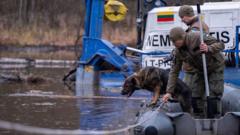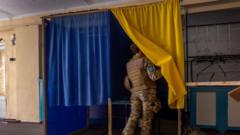As NATO intensifies its aerial patrols in the Baltic region, concerns over potential Russian sabotage of critical underwater infrastructure continue to grow, underscoring the strategic significance of this maritime corridor.
NATO's Baltic Surveillance Mission: Safeguarding Against Russian Threats

NATO's Baltic Surveillance Mission: Safeguarding Against Russian Threats
Increased tensions in the Baltic Sea prompt NATO's surveillance efforts against Russian activities.
The ATLANTIQUE 2 naval surveillance aircraft edged through the clouds, skimming the Baltic Sea, as crew members worked diligently to monitor the movements of Russian warships below. Amid rising threats and tensions, NATO's renewed program aimed at uncovering suspected Russian sabotage has positioned these patrols as crucial for both deterrence and observation, even when armed only with high-resolution cameras rather than missiles.
With a mission targeting high-value naval operations, the aerial crew led by Lieutenant Commander Romain focused on demonstrating presence and vigilance in a highly militarized zone recently marred by incidents involving underwater communication cables and gas pipelines. The apprehension of potential sabotage, attributed primarily to the Kremlin, has prompted this increased surveillance. Over a year, critical underwater infrastructure has been compromised three times under suspicious circumstances, prompting fears of escalating maritime aggression.
On this descent over the Baltic Sea, as chilling reality set in with Russian forces attempting to jam GPS signals and radar lock on the aircraft, the tension in the air was palpable. With Russian naval vessels and submarines vividly apparent below, the NATO mission's necessity became evident. The delicate balance of power in the Baltic is now more precarious than ever, with European officials on high alert as they navigate a complex landscape of military posturing and geopolitical threats. The aerial surveillance missions are not only about observing but about signaling unity and resolve in the face of looming challenges to regional stability.
With a mission targeting high-value naval operations, the aerial crew led by Lieutenant Commander Romain focused on demonstrating presence and vigilance in a highly militarized zone recently marred by incidents involving underwater communication cables and gas pipelines. The apprehension of potential sabotage, attributed primarily to the Kremlin, has prompted this increased surveillance. Over a year, critical underwater infrastructure has been compromised three times under suspicious circumstances, prompting fears of escalating maritime aggression.
On this descent over the Baltic Sea, as chilling reality set in with Russian forces attempting to jam GPS signals and radar lock on the aircraft, the tension in the air was palpable. With Russian naval vessels and submarines vividly apparent below, the NATO mission's necessity became evident. The delicate balance of power in the Baltic is now more precarious than ever, with European officials on high alert as they navigate a complex landscape of military posturing and geopolitical threats. The aerial surveillance missions are not only about observing but about signaling unity and resolve in the face of looming challenges to regional stability.





















